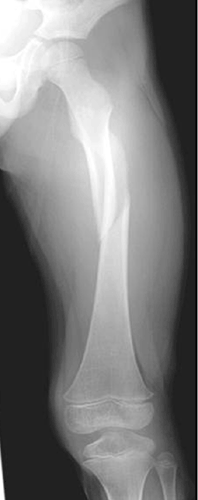More optimal results found with locked vs. unlocked Enders rods for length-unstable pediatric femur fractures
Locked Enders rods demonstrated less postoperative shortening and malrotation of length-unstable pediatric femur fractures, with no additional complications, surgical time or blood loss, compared with unlocked Enders rods, according to data presented at the 2010 Annual Meeting of the Orthopaedic Trauma Association.
“When appropriate rodding technique is used, ‘locking’ Enders rods may allow a surgeon to avoid using a more invasive or expensive choice of fixation and may allow the surgeon to avoid the use of postoperative cast immobilization,” David A. Podeszwa, MD, assistant professor at the University of Texas Southwestern Medical Center in Dallas, told Orthopedics Today.
Retrospective review
Podeszwa and his colleagues conducted a retrospective clinical and radiographic review of all patients who underwent flexible intramedullary (IM) rodding for a length-unstable femoral shaft fracture from 2001 to 2008.
They identified a total of 107 length-unstable fractures, defined as comminuted or spiral fractures that were longer than twice the diameter of the femoral shaft. Seventy patients had been treated with unlocked Enders rods, and 37 were treated with locked Enders rods. The technique involved locking through the eyelet in the distal femur with a 2.7-mm fully threaded, cortical screw.
Podeszwa reported that the locked group contained almost twice the number of comminuted fractures than that in the unlocked group. Otherwise, he and his colleagues found no statistically significant differences between the groups for demographic data, operative variables, including time from injury to surgery, length of surgery or estimated blood loss, fracture pattern or location, time to union, femoral alignment or major complications.
|
|
Images: Podeszwa DA |
Clinical and radiographic results
Researchers found significantly greater shortening of the femur — the change in the distance of the distal end of the rod from its intraoperative position to its position 6 weeks postoperatively — among the unlocked cases. Medially locked Enders rods moved 1.3 mm and laterally locked Enders rods moved 1.9 mm, compared with 12.1 mm for the unlocked Enders rods (P<.05).
In addition, “there was a statistically significant difference in the number of minor complications between these two groups,” Podeszwa said. “A third of the unlocked patients had minor complications vs. less than 10% of the locked group.”
He also reported a statistically significant difference in major complications, or those complications that required a secondary operative procedure, between the two groups.
Podeszwa and his colleagues found no clinical or radiographic evidence of screw breakage, pull-out, loosening or plowing in the metaphysis. They did report significantly more clinical complaints, including limp, gross malrotation, clinical shortening and palpable painful rods, among those patients who received unlocked rods (P<.05).
Podeszwa emphasized that surgeons still need to use the appropriate rodding technique, including using appropriate-length rods and appropriate canal fit. “If poor technique is used, ‘locking’ the Enders rods may not make a difference,” Podeszwa said. “In addition, this technique is not meant to treat all comminuted femoral shaft fractures. For highly comminuted fractures, submuscular plate fixation or solid intramedullary rod fixation will still be the appropriate fixation choice.” – by Tina DiMarcantonio
Reference:
- Ellis HB, et al. A comparison of locked versus nonlocked Enders rods for length-unstable pediatric femoral shaft fractures. Paper 060. Presented at the 2010 Annual Meeting of the Orthopaedic Trauma Association. Oct. 13-16, 2010. Baltimore.
- David A. Podeszwa, MD, can be reached at Children’s Medical Center Dallas, 1935 Medical District Drive, Dallas, TX 75235; 214-456-5614. He has no direct financial interest in any product or company mentioned in this article.
![]() Follow
OrthoSuperSite.com on Twitter
Follow
OrthoSuperSite.com on Twitter


